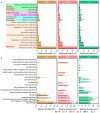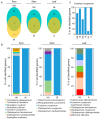Fusarium Wilt Invasion Results in a Strong Impact on Strawberry Microbiomes
- PMID: 38140478
- PMCID: PMC10747085
- DOI: 10.3390/plants12244153
Fusarium Wilt Invasion Results in a Strong Impact on Strawberry Microbiomes
Abstract
Plant-endophytic microbes affect plant growth, development, nutrition, and resistance to pathogens. However, how endophytic microbial communities change in different strawberry plant compartments after Fusarium pathogen infection has remained elusive. In this study, 16S and internal transcribed spacer rRNA amplicon sequencing were used to systematically investigate changes in the bacterial and fungal diversity and composition in the endophytic compartments (roots, stems, and leaves) of healthy strawberries and strawberries with Fusarium wilt, respectively. The analysis of the diversity, structure, and composition of the bacterial and fungal communities revealed a strong effect of pathogen invasion on the endophytic communities. The bacterial and fungal community diversity was lower in the Fusarium-infected endophytic compartments than in the healthy samples. The relative abundance of certain bacterial and fungal genera also changed after Fusarium wilt infection. The relative abundance of the beneficial bacterial genera Bacillus, Bradyrhizobium, Methylophilus, Sphingobium, Lactobacillus, and Streptomyces, as well as fungal genera Acremonium, Penicillium, Talaromyces, and Trichoderma, were higher in the healthy samples than in the Fusarium wilt samples. The relative abundance of Fusarium in the infected samples was significantly higher than that in the healthy samples, consistent with the field observations and culture isolation results for strawberry wilt. Our findings provide a theoretical basis for the isolation, identification, and control of strawberry wilt disease.
Keywords: bacterial community; fungal community; microbiome; plant pathogen; strawberry Fusarium wilt disease.
Conflict of interest statement
The authors declare no conflict of interest.
Figures






Similar articles
-
Endophytic fungal community composition and function response to strawberry genotype and disease resistance.PeerJ. 2025 May 9;13:e19383. doi: 10.7717/peerj.19383. eCollection 2025. PeerJ. 2025. PMID: 40356669 Free PMC article.
-
Characteristics of soil microbial community assembly patterns in fields with serious occurrence of tobacco Fusarium wilt disease.Front Microbiol. 2024 Nov 13;15:1482952. doi: 10.3389/fmicb.2024.1482952. eCollection 2024. Front Microbiol. 2024. PMID: 39606108 Free PMC article.
-
Microbial Community Structure and Diversity of Endophytic Bacteria and Fungi in the Healthy and Diseased Roots of Angelica sinensis, and Identification of Pathogens Causing Root Rot.Microorganisms. 2025 Feb 14;13(2):417. doi: 10.3390/microorganisms13020417. Microorganisms. 2025. PMID: 40005782 Free PMC article.
-
Immunogenicity and seroefficacy of pneumococcal conjugate vaccines: a systematic review and network meta-analysis.Health Technol Assess. 2024 Jul;28(34):1-109. doi: 10.3310/YWHA3079. Health Technol Assess. 2024. PMID: 39046101 Free PMC article.
-
Home treatment for mental health problems: a systematic review.Health Technol Assess. 2001;5(15):1-139. doi: 10.3310/hta5150. Health Technol Assess. 2001. PMID: 11532236
Cited by
-
Diversity and Function of Strawberry Endophytic Bacterial Communities Associated with Host Genotype and Niche.Curr Microbiol. 2025 Apr 16;82(6):244. doi: 10.1007/s00284-025-04223-z. Curr Microbiol. 2025. PMID: 40237826 Free PMC article.
-
Endophytic fungal community composition and function response to strawberry genotype and disease resistance.PeerJ. 2025 May 9;13:e19383. doi: 10.7717/peerj.19383. eCollection 2025. PeerJ. 2025. PMID: 40356669 Free PMC article.
References
-
- Tian Q., Gong Y., Liu S., Ji M., Tang R., Kong D., Xue Z., Wang L., Hu F., Huang L., et al. Endophytic bacterial communities in wild rice (Oryza officinalis) and their plant growth-promoting effects on perennial rice. Front. Plant Sci. 2023;14:1184489. doi: 10.3389/fpls.2023.1184489. - DOI - PMC - PubMed
Grants and funding
- 23KJB210009; 21KJB210012/Natural Science Foundation of the Jiangsu Higher Education Institutions of China
- 2021kj22; 2021kj39/Science Fund of Jiangsu Vocational College of Agriculture and Forestry
- 2023kj02/Yafu Technology Innovation and Service Major Project of Jiangsu Vocational College of Agriculture and Forestry
- 2022kj05/Unveiling and Leading Projects of Jiangsu Vocational College of Agriculture and Forestry
LinkOut - more resources
Full Text Sources

